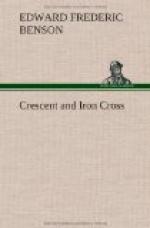We have traced in brief the backward progress of Ottoman domination, and have seen how, from the rough and ready methods of a military barbarism, the Turks evolved a more emphatic and a more highly organised negation of all those principles which we may sum up under the general term of civilisation. The comparatively humane neglect of the unfortunate alien peoples herded within the frontiers of earlier Sultans was improved upon by Abdul Hamid, who struck out the swifter and superior methods of maintaining the dominating strength of the Turkish element in the kingdom not by the absorption of subject peoples, but by their extermination. This in turn, this new and effective idea, served as a first sketch of an artist with regard to his finished picture, and starting with that the Nationalist party enlarged and elaborated it into that masterpiece of massacre which they exhibited to the world in the years 1915 and 1916 of the Christian Era, when from end to end of the Empire there flashed the signal for the extermination of the Armenian race. Abdul Hamid was but tentative and experimental as compared to their systematised thoroughness, but then the Nationalist party had learned thoroughness under the tutelage of its Prussian masters. And in addition to instruction they had had the advantage of seeing how Prussian firmness, with the soothing balm of Kultur to follow, had dealt with the now-subject remnant of Belgians. That was the way to treat subject people: ’the first care of a state is to protect itself,’ as Enver and Talaat could read in the text-books now translated into Turkish, in copies, maybe, presented to them by their Master in Berlin, and Turkey could best show the proof of her enlightenment and regeneration, by following in the footsteps of Prussian Kultur. Perhaps a few thousand innocent men might suffer the inconvenience of having their nails torn out, of being bastinadoed to death, of being shot, burned or hanged, perhaps a few thousand girls and women might die by the wayside in being deported to ‘agricultural colonies,’ might fall victims to the lusts of Turkish soldiers, or have babes torn from their wombs, but these paltry individual pains signified nothing compared to the national duty of ‘suffering the state to run no risks.’ As one of this party of Union and Progress said, ’The innocent of to-day may be the guilty of to-morrow,’ and it was therefore wise to provide that for innocent and guilty alike there should be no to-morrow at all. Years before the statesmanship of Abdul Hamid had prophetically foreseen the dawning of this day, when he remarked ’The way to get rid of the Armenian question is to get rid of the Armenians,’ and temporarily for twenty years he did get rid of the Armenian question. But when, in 1915, Talaat Bey completed his arrangements for a further contribution to the solution of the same problem, he said, ’After this, there will be no Armenian question for fifty years.’ As far as we can judge, he rather under-estimated the thoroughness of his arrangements.[1]




